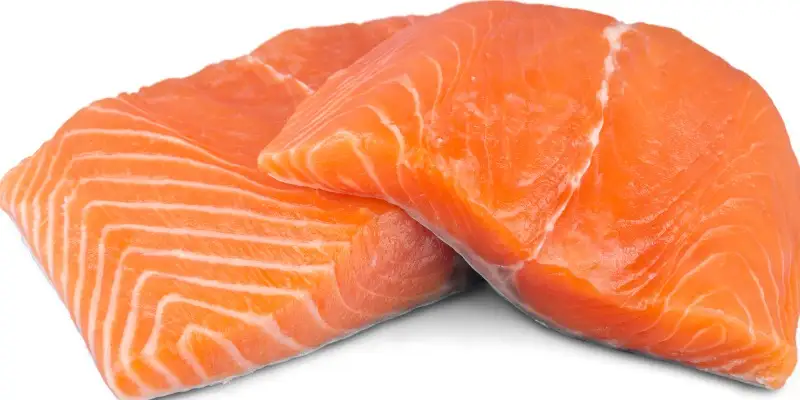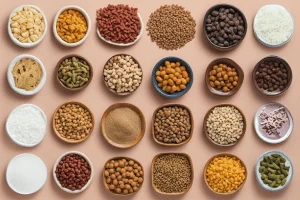Best Meat for Dogs: Top Protein Picks for Happy & Healthy Pets
Published: 2 Nov 2024
Did you know meat is full of protein that helps dogs build strong muscles and stay active? But here’s the big question: What’s the best meat for dogs? With choices like chicken, beef, turkey, and even exotic options, finding the perfect fit can feel like solving a delicious puzzle.
Let’s simplify it!
In this article, we will explore all types of meats that are safe for dogs. We will also discuss which one fits ideally for your pet, how to choose the right amount, how to prepare it for dogs, and some frequently asked questions.
Let’s explore the options and find out what’s best for your dog!
Types of Safe Meat for Dogs
Choosing the best meat can make mealtime exciting for your dog while keeping them healthy and happy. Here’s the list of all the meats that are the perfect source of nutrition for your beloved pet!
- Chicken
- Turkey
- Beef
- Lamb
- Fish (like salmon and tuna)
- Duck & Rabbit
- Venison
- Goat
- Kangaroo
- Pork
- Organ meat or Offal

Let’s discuss each meat’s benefits in detail!
1. Chicken
Chicken is one of the most commonly used meats in pet foods due to its high biological value and digestibility.
- It is rich in essential amino acids, including tryptophan, which supports a calm and healthy mood.
- Chicken is also a good source of vitamins like B6 and B3 and minerals such as potassium and calcium.
- Chicken provides lean protein (low in fat and calories but high in essential nutrients), which helps build and repair muscles.
- It’s also easy to digest, making it ideal for dogs with sensitive stomachs.
However, some dogs may develop allergies to chicken protein. If this occurs, consider rotating with other protein sources.
2. Turkey
Turkey is another lean option that’s low in fat. It’s a good alternative to chicken if your dog is sensitive to it.
- It’s great for dogs that need to manage their weight.
- It contains amino acids like arginine, which supports liver function, and tryptophan.
- Turkey is also rich in B vitamins, including B3 (niacin) and B6. These vitamins are essential for energy and metabolism.
- It is a good source of phosphorus and selenium, which support strong bones and immunity.
3. Beef
Beef is delicious and nutrient-dense. Many dogs love the taste of beef, making it a great choice for picky eaters.
- It provides various essential vitamins and minerals, such as iron, zinc, selenium, and B vitamins.
- Beef provides all the essential amino acids dogs need, particularly lysine, valine, and methionine, which support muscle repair and tissue growth.
| Be cautious! |
|---|
Always choose high-quality, grass-fed beef to avoid artificial additives or preservatives. Also, beef can sometimes cause food sensitivities in pets, so keep the portion under control. |

4. Lamb
Lamb is a flavorful, high-quality protein option for pets, especially those with poultry or red meat allergies. It’s considered a “novel protein,” meaning it’s less likely to cause allergic reactions.
- It’s rich in zinc, iron, and B vitamins, contributing to energy production and optimal growth.
- Feeding lamb regularly can help maintain a shiny coat and reduce dry or itchy skin.
- Lamb also contains carnitine, an amino acid that aids in fat metabolism, supporting healthy weight management.
- The moderate fat content of lamb makes it an excellent option for pets with specific dietary needs.
Overconsumption of lamb may lead to higher fat intake, so you have to be cautious while feeding.
5. Fish
Fish is considered a safer protein option for pets because its protein is unique compared to traditional meats like chicken or beef. Pets sensitive to common proteins are less likely to recognize and react to these unique proteins.
- Fish, particularly fatty fish like salmon and sardines, contain omega-3 fatty acids (EPA and DHA).
- Fish improves joint and heart health and keeps your dog’s coat shiny.
- Fish also contains vitamin D, which supports bone health.
- Fish contain high-quality protein that is easily digestible by sensitive pets.
To avoid heavy metal contamination, do not feed fish that are high in mercury, such as sharks or swordfish. Instead, choose safe options like salmon and tuna.

6. Kangaroo
Kangaroo meat is lean, low-fat, high-protein, and hypoallergenic. It is a sustainable and nutritious choice for dogs.
- It is rich in iron and zinc, supports healthy blood cells, and aids in wound healing.
- It contains high levels of CLA (Conjugated Linoleic Acid), which is known to reduce body fat and improve muscle tone.
| Remember! |
|---|
Wild animals can sometimes carry parasites or diseases that could affect your dog. Ensure the venison is sourced from reputable suppliers to avoid contamination or exposure to harmful substances. |
7. Duck & Rabbit
Duck and rabbit are great options for dogs who need a novel and digestible protein.
- They are rich in iron, zinc, B vitamins, and omega fatty acids.
- Both duck and rabbit meat provide amino acids and connective tissue components that support collagen production. Collagen is essential for maintaining healthy cartilage in joints, helping to prevent wear and tear that can lead to joint issues.
Duck can be high in fat, which can cause weight gain or pancreatitis if fed in excess. Rabbit, on the other hand, is leaner and lower in fat, making it a suitable option for dogs needing a low-fat diet.
8. Goat
Goat meat is a fantastic protein choice for dogs. It offers a unique flavour.
- It contains B vitamins (including B12), iron, zinc, phosphorus, omega fatty acids, and selenium, which support nerve function, red blood cell formation, and overall health.
- Goat tripe (the edible lining of a goat’s stomach) offers probiotics that soothe gastrointestinal discomfort and improve nutrient absorption.
- Fresh or frozen goat meat has low histamine content, reducing the risk of allergic reactions and intolerance.
When included in a balanced diet, goat meat can be a beneficial, safe alternative to poultry or red meat for pets with allergies. However, always consult a veterinarian to ensure the best dietary choices for pets with specific sensitivities.
9. Venison
Venison is lean, nutritious, novel meat often included in dog foods and treats. Its unique protein profile can help manage dietary restrictions while still providing essential nutrients.
- Venison is relatively low in fat compared to beef or pork. This makes it suitable for overweight dogs or those managing weight-related health issues.
- Venison is often recommended for senior dogs, as many experience joint issues or arthritis. Venison provides nutrients like phosphorus and other minerals, iron, and zinc that support joint health and reduce inflammations in them.
10. Pork
Pork is a flavorful and protein-packed option that many dogs enjoy. It’s an excellent choice for adding variety to your dog’s diet.
- Pork contains thiamine (Vitamin B1), which helps convert carbohydrates into energy, keeping dogs active and playful.
- Pork also contains phosphorus, selenium, zinc, iron, and niacin, which support the production and repair of DNA.
- It also contains taurine, an amino acid that assists in the formation of bile acids, which helps dogs digest fats efficiently.
However, Pork is high in fat. To avoid excessive fat, opt for lean cuts, like tenderloin. Always cook pork thoroughly to eliminate harmful parasites like trichinella.
11. Organ Meat or Offal
Organ meat, also known as offal, is highly nutritious and offers a variety of benefits for dogs.
- Organ meats, including liver, kidney, and heart, contain high levels of vitamins A, B, D, and E and minerals like iron, copper, phosphorus, selenium, and zinc.
- Organ meats contribute to healthy liver, kidney, and heart function. For example, kidneys are rich in iron, and the heart is packed with taurine, which supports heart health.
- Organ meats are highly digestible, making them suitable for dogs with sensitive stomachs.
Some organ meats, particularly liver, can be high in cholesterol. Feeding them in moderation is important to avoid potential health issues related to high cholesterol levels.
What’s the Best Meat For Your Dog?
We’ve explored 12 types of safe meats for dogs, but how do you choose the best one for your furry friend? Below is a simple table to help you compare and select the most suitable meat for your dog based on factors like their protein and fat content per 100 grams:
| Meat Type | Protein (%) | Fat (%) | Best For |
|---|---|---|---|
| Chicken | 25 | 8 | Active dogs |
| Turkey | 27 | 8 | Dogs with Sensitive stomachs |
| Beef | 26 | 10 | Dogs with weak muscles |
| Lamb | 26 | 12 | Puppies, pregnant dogs |
| Fish | 22 | 15 | Dogs with skin and coat problems |
| Duck | 26 | 11 | Dogs with food allergies and sensitivities |
| Rabbit | 30 | 9 | Small breeds needing a low-fat diet |
| Venison | 28 | 9 | Active, high-energy dogs |
| Goat | 27 | 6 | Dogs with stomach issues |
| Kangaroo | 26 | 2 | Dogs who need a high-protein, low-fat diet |
| Pork | 25 | 8 | Dogs require weight management |
| Organ Meat/Offal | 18-22 | 5-15 | Best for dogs with weak joints, health issues, weight management |
How to Serve Meat to Your Dog? Cooked or Raw
When it comes to serving meat to your dog, you have two main options: cooked or raw.
Each method has its own benefits, but the decision depends on your dog’s health, preferences, and your comfort level with handling raw food. Here’s a table showing the benefits and drawbacks of both cooked and raw meats:
Here’s a table showing the benefits and drawbacks of cooked and raw meats for dogs:
| Cooked Meat | Raw Meat |
|---|---|
| Cooking kills harmful bacteria and parasites, making it safer for dogs. | Retains all natural nutrients, enzymes, and moisture. |
| Easier to digest for dogs with sensitive stomachs. | Mimics a dog’s ancestral diet, which some believe promotes better health. |
| Reduces the risk of foodborne illnesses for humans handling it. | It can improve dental health due to chewing on raw bones. |
| Cooking can reduce certain nutrients like vitamins and enzymes. | Higher risk of bacterial contamination (e.g., salmonella, E. coli). |
| Requires time and effort to prepare properly. | Requires careful sourcing and storage to ensure freshness and safety. |
| Overcooking may lead to nutrient loss. | Not suitable for dogs with compromised immune systems or certain health conditions. |
| Advice for Dog Owners! |
|---|
As a veterinarian, I recommend always cooking meat before feeding it to your dog. Cooking eliminates the risk of bacteria and ensures safer digestion. |
What Happens If a Dog is Allergic to Meat?
Some dogs cannot digest meat. “Around 10% of all allergies in dogs are food-related, with common triggers being chicken, beef, and dairy”, says VCA Animal Hospitals.
If you notice some strange behaviours in your dog after feeding meat, it could be a sign of a meat allergy. Here are some things to look out for:
- Itchy Skin
- Red or Inflamed Skin
- Ear Infections
- Vomiting
- Diarrhea
- Weight Loss
- Lethargy
- Change in Coat Condition
- Increased Urination or Thirst
If you notice any of these signs, chatting with your vet is a good idea. They can help figure out what’s going on and how to keep your furry friend feeling their best!
How Much Meat Should You Feed Your Dog?
Feeding your dog the right amount of meat is important for its health and well-being. The portion depends on its size, age, activity level, and type of meat. Larger dogs require more meat than smaller dogs, and active dogs need more protein to support their energy needs.
Here’s a simple guide to help you determine how much meat to feed your dog:
Small Dogs (up to 25 lbs):
- Around 1/4 to 1/2 cup of meat per meal.
Medium Dogs (25-50 lbs):
- Approximately 1/2 to 1 cup of meat per meal.
Large Dogs (50-100 lbs):
- Around 1 to 2 cups of meat per meal.
Giant Dogs (over 100 lbs):
- About 2 to 3 cups of meat per meal.
If you need more clarification, talk to your vet. They can help you choose the best portion sizes based on your dog’s needs. Balance meat with other nutrients like veggies, fruits and grains for a well-rounded diet.
| Tips for Feeding Meat! |
|---|
|
Conclusion
OK, guys. By now, you know what’s the best meat for dogs.
Feeding your dog high-quality, properly cooked meat can be a healthy and enjoyable addition to their diet. Remember to avoid seasoning and maintain a balanced diet with other nutritious foods. If you’re unsure about the right portion or type of meat for your dog, consult your vet. Take the time to explore different meat options and see which works best for your furry friend.
Ready to try something new for your dog’s meals? Share your thoughts in the comments below.
FAQs
Let’s uncover some frequently asked questions about dogs and meats!
Dogs need meat because it’s a rich source of protein. According to the Association of American Feed Control Officials (AAFCO), adult dogs require at least 18% of their daily calories from protein. Protein helps them build strong muscles, stay energetic, and maintain healthy skin and fur. Meat also provides essential vitamins and minerals, like iron and zinc, that support their immune system and keep them feeling their best.
The best cuts of meat for dogs are organs like the liver, kidney, and heart. They are enriched with nutrients like proteins and fatty acids. The second option is lean meat, which includes chicken breast, turkey, lean beef, and lamb. These cuts provide protein without excess fat, which is important for your dog’s health.
If your dog shows signs of an allergy, such as itching, vomiting, or diarrhoea, immediately stop feeding them the new meat. Consult your veterinarian for advice on identifying the allergen and developing a suitable diet plan.
While some pet owners feed their dogs raw meat as part of a raw food diet, it can carry risks of bacteria like Salmonella. Cooking meat is generally safer, as it eliminates harmful bacteria and parasites.
You can include meat in your dog’s meals daily, but it’s important to balance it with other nutrients. For a balanced diet, aim for meat to make up about 10-30% of their daily food intake, depending on their size and activity level.
Yes, avoid processed meats such as hot dogs and sausages, as they can be high in unhealthy fats and sodium. Also, never feed your dog meat seasoned with garlic or onion, as these can be toxic to dogs.
Look for meat labelled as organic or human-grade, which often indicates higher quality. Freshness is key, so check the expiration date and look for a firm texture and a clean smell without any off-putting odours.
Introduce new meat slowly by mixing it with their current food. Start with a small amount. Gradually increase the portion over a week while monitoring for signs of digestive upset or allergies.
Yes, mixing different meats can provide a broader range of nutrients and keep your dog’s meals interesting. It helps prevent dietary boredom and ensures your dog gets various amino acids and vitamins.
Monitor your dog’s energy levels, coat condition, and overall health. If your dog is active, has a shiny coat, and maintains a healthy weight, they are likely getting enough protein. Consult your vet for specific dietary recommendations based on your dog’s needs.
Yes, meat can be an excellent training treat due to its high palatability. Just ensure you’re using small pieces to avoid overfeeding and consider it part of their daily calorie intake.
If your dog refuses the meat, try different cooking methods or consider mixing it with their favourite food. Adding a bit of safe broth or veggies can enhance the flavour and make it more appealing.
You can give your dog leftovers, but be cautious. Avoid foods toxic to dogs, such as onions, garlic, chocolate, or fatty scraps. Always check the ingredients and ensure the meal is safe for your dog.
Cooking methods like baking, boiling, and grilling are best for dog-friendly meats. These methods keep the meat healthy without added fats or harmful seasonings, making it safer for your dog to eat.

- Be Respectful
- Stay Relevant
- Stay Positive
- True Feedback
- Encourage Discussion
- Avoid Spamming
- No Fake News
- Don't Copy-Paste
- No Personal Attacks

- Be Respectful
- Stay Relevant
- Stay Positive
- True Feedback
- Encourage Discussion
- Avoid Spamming
- No Fake News
- Don't Copy-Paste
- No Personal Attacks





